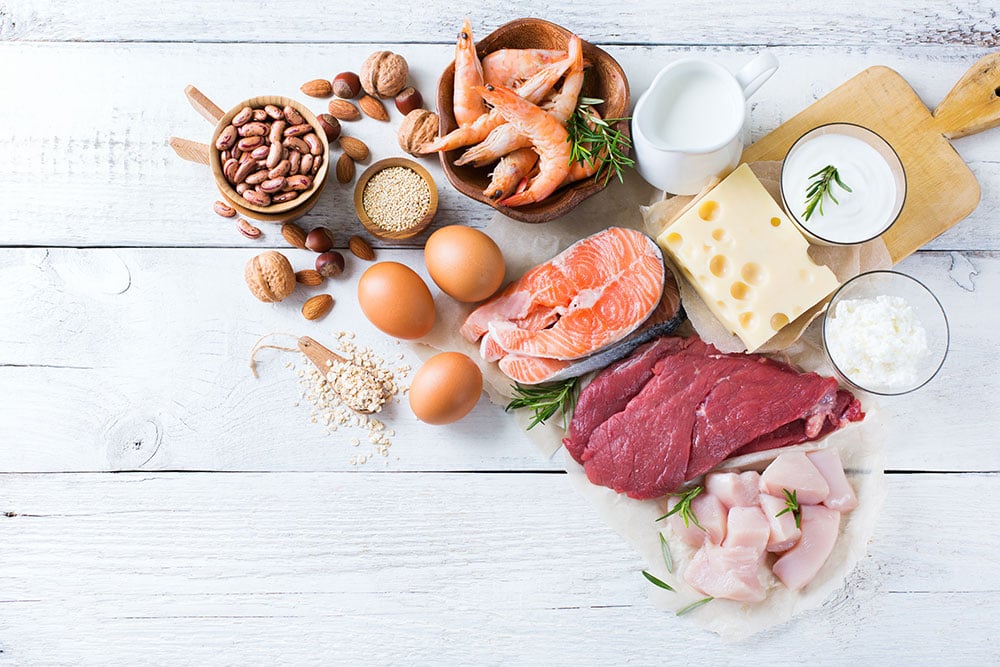
Written by Victoria Black, National Food Ingredients Technical Development Specialist, Canada
Over the past few years, the clean label trend has continued to grow and evolve, giving it a permanent presence in the food industry. In 2019, an average of 35% of all new food and drink products were launched with natural claims* around the world, an increase of 30% since 20151. Complimented by the health and wellness trend, consumers are demanding more natural, healthier and wholesome foods whilst still having great taste, texture, and appearance throughout their shelf life. According to Mintel GNPD, 60% of US consumers considered natural products to be free from additives and preservatives1. However, going preservative free does not come without its challenges, especially when targeting traditional shelf life requirements.
As we move towards foods that are preservative free, there is an inherent risk of excess food waste due to spoilage. According to the Food and Agricultural Organization of the United Nations (FAO), there is 1.3 billion tonnes of waste annually for edible components of food globally2. Of that number, approximately 31% of food waste occurs in households due to the foods being close to, or beyond, the best before date, or due to deviation of acceptable taste, texture, or colour3.
Vying to compliment the clean label trend while focusing on food sustainability can be more than a little tricky, especially when deciding if a preservative is necessary and if so, which one to use. Together, let’s explore when to lose preservatives, when to use preservatives, and when to use natural alternatives in order to maintain the safety and quality of food products throughout the shelf life.
Hurdle technology and when to use a preservative
Knowing when to use a preservative is not always intuitive. Using hurdle technology, you can methodically select processing steps and formulation parameters that can be controlled to limit the need of a preservative. Hurdle technology includes seven processing steps that, when used alone or together, improve the overall safety of the food system:
- High temperature during processing
- Low temperature during storage
- Reduced water activity
- Increased acidity
- Removal of oxygen
- Biopreservatives (naturally occurring preservatives through processing methods like fermentation)
- Added preservatives2
Effective use of hurdle technology through processing, ingredients, and packaging will inhibit the growth of the microorganisms present at the beginning of the food manufacturing process, providing enhanced food safety throughout the shelf life4.
Choosing which processing steps to use is dependent on the type of food manufactured and its intrinsic qualities. In many cases, integration of all hurdle technology steps is not possible due to loss of taste, texture, and/or colour in the food product. It’s here that the use of preservatives is essential to ensure safety, limit microbial spoilage and maintain overall quality of the food.
Efficacy of conventional preservatives
Conventional preservatives are synthetically derived chemical substances that have been approved for food applications in accordance with specific maximum usage levels per regulating bodies. Due to their functionality as antimicrobials, antioxidants, and/or enzyme inhibitors5, conventional preservatives are highly effective to maintain food safety and quality over the product’s intended shelf life. However, there is not always “a one preservative fits all” solution, nor is each preservative effective in all food products. Rather, the selection of the right preservative system based on the target functionality and food design is critical to ensure its efficacy.
Antimicrobials
Antimicrobial preservatives inhibit the growth of bacteria, molds, yeasts and in some cases bacterial spores. Common antimicrobials include organic weak acids and their salts, such as acetic acid; lactic acid; benzoic acid and sodium benzoate; propionic acid, calcium propionate and sodium propionate; and sorbic acid and potassium sorbate6. In general, weak acids work to inhibit microbial growth through several mechanisms, including disruption of the cell membrane, inhibition of essential cellular metabolic processes, imposed stress on the cell’s internal pH system, and accumulation of toxic anions as the weak acids dissociate within the cell6. Nitrates and nitrites are also widely used groups of antimicrobial agents that, through a series of reactions and by-products, work to inhibit clostridium botulinum and listeria monocytogenes in cured and ready to eat meat products7. In addition to their antimicrobial efficacy, nitrites also provide antioxidant effects and inhibition of enzyme activity, resulting in flavour and colour retention7.
Chelating agents, such as ethylenediaminetetraacetic acid (EDTA), hydroxycarboxylic acids (citric acid, lactic acid, malic acid, tartaric acid), lactates and polyphosphates, have been shown to inhibit microbial growth and enzymatic activity through interactions of the cell membrane of gram negative bacteria and certain yeasts as well as sequestration of metal ions respectively8.
Antioxidants
Antioxidant preservatives are any approved food additives or natural food ingredients that protect against rancidity, discoloration, and deterioration caused by oxidation9. As reducing agents, antioxidants react with oxygen present in the food system to eliminate the oxidation of the other food components, reducing the risk of food spoilage10 like changes in flavour and colour. Common antioxidants include, but are not limited to, ascorbic acid (Vitamin C) and ascorbates, butylatedhydroxyanisole (BHA), butylatedhydroxytoluene (BHT), propyl gallate, and tocopherols10.
Enzyme inhibitors
Enzyme inhibitors work to prevent catalyst reactions from occurring in food systems in order to control food deterioration, such as enzymatic browning in foods and beverages9. Chemical enzyme inhibitors generally function in one of two ways—either through direct interaction with the enzyme, or through reaction with the enzyme’s substrate making it no longer possible to interact with the enzyme9. Classes of common chemical enzyme inhibitors include, but are not limited to, sulfiting agents, antioxidants, acidulants, and chelating agents9, with each one targeting a specific enzyme under certain conditions.
Natural Preservatives
Although conventional preservatives remain highly functional and cost effective, natural preservatives are making their way to the forefront of product development for food preservation and shelf life enhancement. Natural preservatives are derived from natural sources, like plants, animals and microorganisms, and their efficacies are generally linked to the source’s natural defense mechanism11. Like conventional preservatives, natural preservatives also work to inhibit microbial growth by directly interacting with the cell membrane and influencing internal cell processes. Here are some examples of natural preservatives available in the market today.
Plant-based natural preservatives
Plant-based natural preservatives are derived from functional plant extracts and encompass polyphenols and phenolics, essential oils, and plant antimicrobial peptides (pAMP)11. In addition to antimicrobial activities, select plant extracts also have chelating abilities binding metal ions to help prevent oxidation and enzymatic reactions11. Common plant-based natural preservatives include extracts of cinnamon, cranberry, cumin, garlic, green tea extract, licorice extract, oregano, and rosemary, to name a few.
Animal-based natural preservatives
Animal-based natural preservatives include functional enzymes (lysozyme and lactoperoxidase), proteins (lactoferrin), antimicrobial peptides, and polysaccharides (chitosan), and work to interfere in various microbial cell processes to inhibit growth11. Although naturally derived, these preservatives have limited application uses due to their animal origin.
Microbial-derived natural preservatives
Lastly, natural preservatives derived from microorganisms include natamycin, nisin, pediocin, and reuterin11. Bacteriocins, like nisin, have risen in popularity due to their natural occurrence in fermented products such as yogurt. A second class of microbial-derived preservatives include microbial fermentates, which are food ingredients (for example, whey, wheat and sugar) that have been cultured with bacteria to produce naturally occurring organic acids, like propionates, or inhibitory peptides like bacteriocins12. The efficacy of microbial fermentates is dependent on the bacterial culture used, but is not limited to inhibition of bacterial growth, as well as inhibition of yeast and mold growth12.
As with any preservative, choosing the right natural preservative solution will depend on the product type; product characteristics such as target flavour, pH, and water activity; production process; and target shelf life. Despite being naturally-derived, some natural preservatives, like natamycin and nisin, are regulated and permissible limits and applications should always be verified prior to use.
Solutions for your business
As the need for distribution tolerance, improved sustainability, and heightened transparency among consumers increases, food preservation techniques must also evolve. Whether you’re looking for conventional preservatives, natural alternatives, or formulation support, our team at Univar Solutions is equipped to help you find the right solutions for your products. Contact us today to discover the right preservative solution for your business.
*Mintel's definition of a natural claim includes the following five claims: no additives/preservatives, GMO-free, organic, wholegrain, all-natural product
1E. Schofield (2019). The evolution of clean in food and drink. Retrieved from Mintel GNPD Academic database
2Food and Agriculture Organization of the United Nations (2013). Food wastage footprint: impacts on natural resources summary. Retrieved from http://www.fao.org/news/story/en/item/196402/icode/
3J. Aschemann-Witzel, I. de Hooge, P. Amani et. al. (2015). Consumer-related food waste: causes and potential for action, Sustainability, 7, 6457 – 6477, doi:10.3390/su7066457
4L. Leistner, G. Gould (2012). Hurdle technologies: combination treatments for food stability, safety and quality, Springer Science & Business Media, p 18 – 20
5American Chemical Society (2002). Focusing on preservatives: how they keep food fresh. Science Daily. Retrieved from www.sciencedaily.com/releases/2002/11/021113070827.htm
6S. Brul, P. Coote (1999). Preservative agents in foods: mode of action and microbial resistance mechanisms, International Journal of Food Microbiology, 50, 1 – 17, doi: 10.1016/s0168-1605(99)00072-0
7R. Cammack, C. Joannou, X. Cui et. al. (1999). Nitrite and nitrosyl compounds in food preservation, Biochimica et Biophysica Acta (BBA) – Bioenergetics, 1411:2 – 3, 475 – 488, doi: 10.1016/S0005-2728(99)00033-X
8L. Shelef (1994). Antimicrobial effects of lactates: a review, Journal of Food Protection, 57:5, 445- 450, doi: 10.4315/0362-028X-57.5.445
9I. Ashie, B. Simpson, J. Smith (1996). Mechanisms for controlling enzymatic reactions in foods, Critical Reviews in Food Science & Nutrition, 36:1 – 2, 1 – 30, doi: 10.1080/10408399609527716
10R. Franco, G. Navarro, E. Martinez-Pinilla (2019). Antioxidants versus food antioxidant additives and food preservatives, Antioxidants (Basel), 8:11, 542, doi: 10.3390/antiox8110542
11N. Lee, H. Paik (2016). Status, antimicrobial mechanism, and regulation of natural preservatives in livestock food systems, Korean Journal for Food Science of Animal Resources, 36:4, 547-557, doi: 10.5851/kosfa.2016.36.4.547
12T. Taylor (2015). Handbook of Natural Antimicrobials for Food Safety and Quality, Elsevier Ltd. p 80

Access your SDS now through your account. New customers can request one here.

![Preservatives – use them, lose them, or use a natural alternative? [translations pending] banner image](https://discover.univarsolutions.com/assets/components/phpthumbof/cache/default-banner.2d43893cc9ef3517824746e94ab2c4418427.png)
 EMEA
EMEA Latin America
Latin America North America
North America Asia
Asia